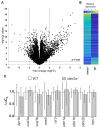Knockout of stim2a Increases Calcium Oscillations in Neurons and Induces Hyperactive-Like Phenotype in Zebrafish Larvae
- PMID: 32867296
- PMCID: PMC7503814
- DOI: 10.3390/ijms21176198
Knockout of stim2a Increases Calcium Oscillations in Neurons and Induces Hyperactive-Like Phenotype in Zebrafish Larvae
Abstract
Stromal interaction molecule (STIM) proteins play a crucial role in store-operated calcium entry (SOCE) as endoplasmic reticulum Ca2+ sensors. In neurons, STIM2 was shown to have distinct functions from STIM1. However, its role in brain activity and behavior was not fully elucidated. The present study analyzed behavior in zebrafish (Danio rerio) that lacked stim2a. The mutant animals had no morphological abnormalities and were fertile. RNA-sequencing revealed alterations of the expression of transcription factor genes and several members of the calcium toolkit. Neuronal Ca2+ activity was measured in vivo in neurons that expressed the GCaMP5G sensor. Optic tectum neurons in stim2a-/- fish had more frequent Ca2+ signal oscillations compared with neurons in wildtype (WT) fish. We detected an increase in activity during the visual-motor response test, an increase in thigmotaxis in the open field test, and the disruption of phototaxis in the dark/light preference test in stim2a-/- mutants compared with WT. Both groups of animals reacted to glutamate and pentylenetetrazol with an increase in activity during the visual-motor response test, with no major differences between groups. Altogether, our results suggest that the hyperactive-like phenotype of stim2a-/- mutant zebrafish is caused by the dysregulation of Ca2+ homeostasis and signaling.
Keywords: PTZ; SOCE; Stim2a; behavioral tests; calcium toolkit; glutamate; hyperactivity; zebrafish.
Conflict of interest statement
The authors declare no conflict of interest.
Figures











Similar articles
-
stim2b Knockout Induces Hyperactivity and Susceptibility to Seizures in Zebrafish Larvae.Cells. 2020 May 21;9(5):1285. doi: 10.3390/cells9051285. Cells. 2020. PMID: 32455839 Free PMC article.
-
Lack of Stim2 Affects Vision-Dependent Behavior and Sensitivity to Hypoxia.Zebrafish. 2023 Aug;20(4):146-159. doi: 10.1089/zeb.2022.0068. Zebrafish. 2023. PMID: 37590563
-
Loss of Stim2 in zebrafish induces glaucoma-like phenotype.Sci Rep. 2024 Oct 18;14(1):24442. doi: 10.1038/s41598-024-74909-0. Sci Rep. 2024. PMID: 39424970 Free PMC article.
-
Molecular physiology and pathophysiology of stromal interaction molecules.Exp Biol Med (Maywood). 2018 Mar;243(5):451-472. doi: 10.1177/1535370218754524. Epub 2018 Jan 24. Exp Biol Med (Maywood). 2018. PMID: 29363328 Free PMC article. Review.
-
STIM Proteins and Glutamate Receptors in Neurons: Role in Neuronal Physiology and Neurodegenerative Diseases.Int J Mol Sci. 2019 May 9;20(9):2289. doi: 10.3390/ijms20092289. Int J Mol Sci. 2019. PMID: 31075835 Free PMC article. Review.
Cited by
-
The Roles of Histamine Receptor 1 (hrh1) in Neurotransmitter System Regulation, Behavior, and Neurogenesis in Zebrafish.Mol Neurobiol. 2023 Nov;60(11):6660-6675. doi: 10.1007/s12035-023-03447-z. Epub 2023 Jul 20. Mol Neurobiol. 2023. PMID: 37474883 Free PMC article.
-
New insights into the stromal interaction molecule 2 function and its impact on the immunomodulation of tumor microenvironment.Cell Biosci. 2024 Sep 13;14(1):119. doi: 10.1186/s13578-024-01292-8. Cell Biosci. 2024. PMID: 39272139 Free PMC article. Review.
References
MeSH terms
Substances
Grants and funding
LinkOut - more resources
Full Text Sources
Molecular Biology Databases
Miscellaneous

